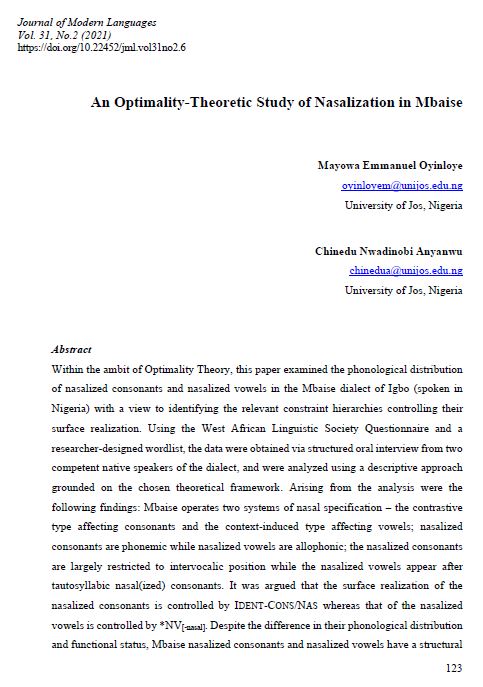An Optimality-Theoretic Study of Nasalization in Mbaise
Main Article Content
Abstract
Within the ambit of Optimality Theory, this paper examined the phonological distribution of nasalized consonants and nasalized vowels in the Mbaise dialect of Igbo (spoken in Nigeria) with a view to identifying the relevant constraint hierarchies controlling their surface realization. Using the West African Linguistic Society Questionnaire and a researcher-designed wordlist, the data were obtained via structured oral interview from two competent native speakers of the dialect, and were analyzed using a descriptive approach grounded on the chosen theoretical framework. Arising from the analysis were the following findings: Mbaise operates two systems of nasal specification ‒ the contrastive type affecting consonants and the context-induced type affecting vowels; nasalized consonants are phonemic while nasalized vowels are allophonic; the nasalized consonants are largely restricted to intervocalic position while the nasalized vowels appear after tautosyllabic nasal(ized) consonants. It was argued that the surface realization of the nasalized consonants is controlled by IDENT-CONS/NAS whereas that of the nasalized vowels is controlled by *NV[-nasal]. Despite the difference in their phonological distribution and functional status, Mbaise nasalized consonants and nasalized vowels have a structural relationship within the syllable in which they occur. Therefore, it was concluded that their well-formedness is governed by a single hierarchy: IDENT-CONS/NAS, *NV[-nasal] >> *FRIC/NAS, *LIQ/NAS >> *CONS/NAS, *V/NAS >> IDENT-IO(nasal).

